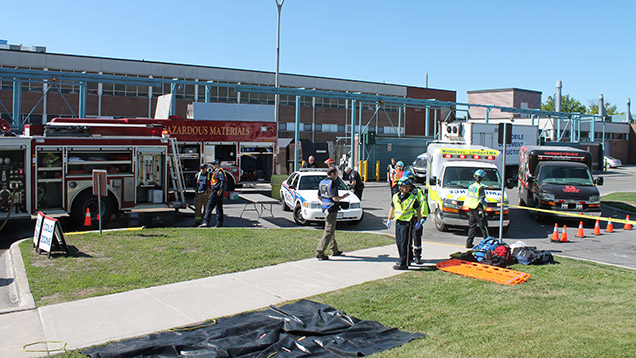Emergency responders tested in mock chemical attack
 CREDIT: ANDREW VIDLER
CREDIT: ANDREW VIDLEREmergency Services respond to a mock chemical attack on campus as a part of Project H.E.R.O.
A residence room lies torn to shreds. Bloodstains, plants and assorted debris lie scattered, marking the location that Will Johnston began to formulate his plan to ‘get even' with the rest of the student population. After his plan has been carried out, the school is swarmed with emergency services, hazmat teams are decontaminating victims, and the bodies of casualties lie on the grass. Half of the campus looks like a scene out of a movie.
“Actually this might not be the biggest, but it's pretty close,” explained acting School of Public Safety Chair Mark Hunter, reflecting on the scope of this year's iteration of Project H.E.R.O., the yearly emergency response simulation that takes place on campus. The elaborate layout, from the meticulously detailed crime scene to the wounded and screaming victims, are all a part of a training exercise that tests the emergency response skills of not only Fanshawe students, but London emergency services as well. Even the handcuffed Johnston and his bloodied girlfriend are just playing a part in order to help current and future responders train for this eventuality.
“We have just shy of 300 people participating in the exercise this year,” said Kris Nagal, employee at Fanshawe's Emergency Management office and a member of the event's planning committee. When asked about the process that goes into establishing the scenario, he detailed how the planning committee discovers the training goals of the varied participating organizations. “The London police wanted to test their response in evacuating a building, and the fire department wanted to test their hazmat team, so we needed a scenario that would accommodate both.” It was not only London emergency services participating, but Paramedic teams from Oxford and Elgin County, and the decontamination team from the London Health Science Centre, as the simulated pesticide attack gave ample opportunity for them to test out their own procedures and response.
“The overall goal of the exercise is to test our readiness in the event of a real emergency, while also allowing our students to experience what a real-life situation will be for them once they graduate,” explained Hunter, “not just for the students in the paramedic program, but those in emergency management and dispatch as well.” One of those students, Katherine Polack, an emergency management student, found it to be a valuable experience. “We got to really see how an incident like this would be dispatched, and how chaotic it can really be.”
This year's simulation is the fifth such event that has been hosted on campus, with situations of past years including an airplane crashing into residence, an active shooter, and a vehicle crash. Each year, the simulations have become more and more involved, as the participating organizations become more involved with each year. “The number of people we have participating this year shows the tremendous support that our community partners have for this,” said Hunter. “It really is the perfect training opportunity.”
To view photos from this year's emergency response simulation, view the Project H.E.R.O. photo album on the Fanshawe Student Union's Facebook page.














